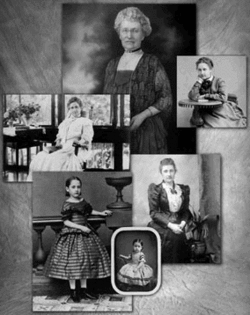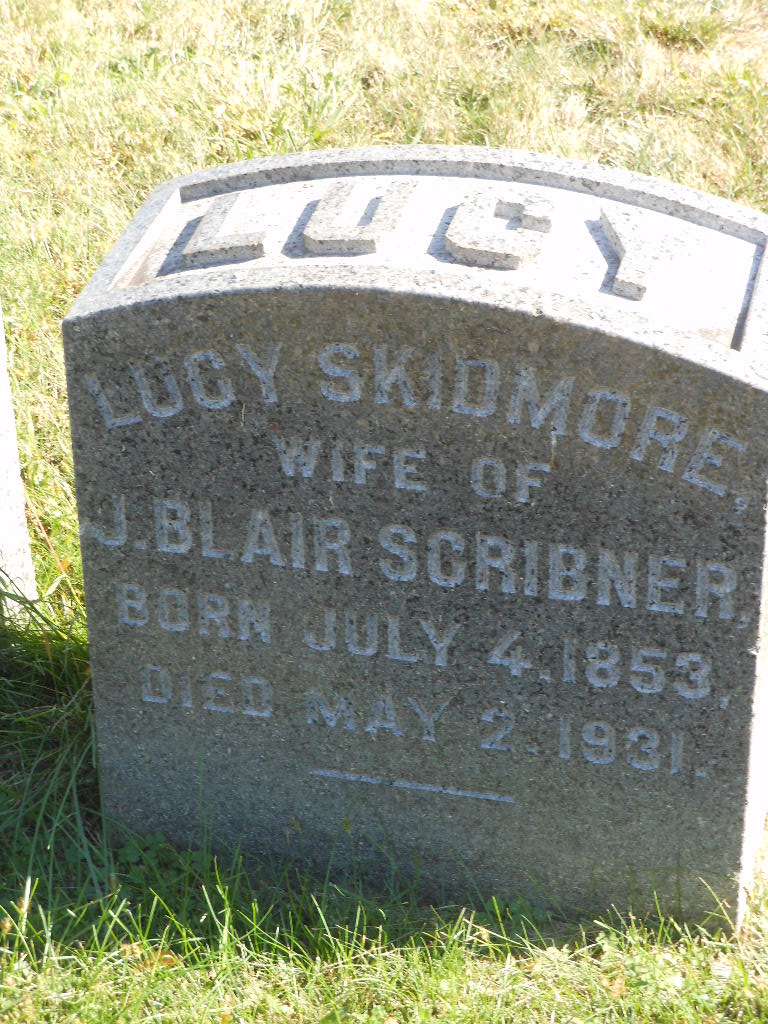Lucy was also a devoted Presbyterian who believed in the importance of service to the community, and taught in her spare time at a mission school connected to her church.
Lucy was introduced to society at 19, and 1875, at the age of 21, she married John Blair Scribner, who had taken over the publishing company started by his father five years earlier, when he was only 20. After a honeymoon in Europe, the couple settled in New York.
But life was not happy for Lucy in the beginning of her marriage; both her children died in infancy, and in 1879, her husband died suddenly of pneumonia. Lucy moved back to the home of her father and stepmother. In the 1880 U.S. Federal Census, Lucy, her father, stepmother, & 3 young Irish female servants were also listed. Lucy was noted to be a widow.
Three years later she lost her father as well. For the next dozen years she lived with her stepmother, who was apparently a loving companion, and less than twenty years older than her stepdaughter. Lucy studied piano, attended concerts and traveled with her stepmother. She did charity work; reading to the blind, teaching sewing to poor girls at the mission school, and she even organized a children's club for the little girls of Jackson, New Hampshire, where she spent several summers. After her stepmother's death in 1894 she continued to visit members of her extended family, including an aunt and uncle in Saratoga Springs, NY, where in 1897 she purchased a summer home on North Broadway.
At the turn of the century Lucy decided to settle permanently in Saratoga Springs, joining the Second Presbyterian church and looking around for appropriate charitable work. Inspired by stories of a Brooklyn settlement house which was the beneficiary of work by several of her friends, Lucy approached four women of her church and asked them to join her in establishing the Young Women's Industrial Club, to "help little girls and young women to become self-supporting and to provide a social center for them." The five church ladies met on January 23, 1903 and opened the club in the old church parsonage on Spring Street in June of that year.
The club's bylaws specified that it would be open to "all girls and women of good character, regardless of race or religion." Boys and men were allowed to participate in all club classes and activities except for physical culture (although their tuition was 10 cents more each term), and once the YWIC had evolved into the Skidmore School of Arts in the 'teens, there were even a few male graduates of the programs in business and music. The school eventually became Skidmore College.
Skidmore was an all-girls school until sometime in the 1970s, after I graduated. No one in my class was too happy about that, but times have changed and everyone is used to it now. It is considered an excellent school and acceptance to the program can be difficult. Skidmore specializes in programs in the Fine Arts, but there was a nursing program when I attended, which was affiliated with NYU-Bellvue Medical Center in NYC. This nursing program was also phased out in the 1970s
Lucy was also a devoted Presbyterian who believed in the importance of service to the community, and taught in her spare time at a mission school connected to her church.
Lucy was introduced to society at 19, and 1875, at the age of 21, she married John Blair Scribner, who had taken over the publishing company started by his father five years earlier, when he was only 20. After a honeymoon in Europe, the couple settled in New York.
But life was not happy for Lucy in the beginning of her marriage; both her children died in infancy, and in 1879, her husband died suddenly of pneumonia. Lucy moved back to the home of her father and stepmother. In the 1880 U.S. Federal Census, Lucy, her father, stepmother, & 3 young Irish female servants were also listed. Lucy was noted to be a widow.
Three years later she lost her father as well. For the next dozen years she lived with her stepmother, who was apparently a loving companion, and less than twenty years older than her stepdaughter. Lucy studied piano, attended concerts and traveled with her stepmother. She did charity work; reading to the blind, teaching sewing to poor girls at the mission school, and she even organized a children's club for the little girls of Jackson, New Hampshire, where she spent several summers. After her stepmother's death in 1894 she continued to visit members of her extended family, including an aunt and uncle in Saratoga Springs, NY, where in 1897 she purchased a summer home on North Broadway.
At the turn of the century Lucy decided to settle permanently in Saratoga Springs, joining the Second Presbyterian church and looking around for appropriate charitable work. Inspired by stories of a Brooklyn settlement house which was the beneficiary of work by several of her friends, Lucy approached four women of her church and asked them to join her in establishing the Young Women's Industrial Club, to "help little girls and young women to become self-supporting and to provide a social center for them." The five church ladies met on January 23, 1903 and opened the club in the old church parsonage on Spring Street in June of that year.
The club's bylaws specified that it would be open to "all girls and women of good character, regardless of race or religion." Boys and men were allowed to participate in all club classes and activities except for physical culture (although their tuition was 10 cents more each term), and once the YWIC had evolved into the Skidmore School of Arts in the 'teens, there were even a few male graduates of the programs in business and music. The school eventually became Skidmore College.
Skidmore was an all-girls school until sometime in the 1970s, after I graduated. No one in my class was too happy about that, but times have changed and everyone is used to it now. It is considered an excellent school and acceptance to the program can be difficult. Skidmore specializes in programs in the Fine Arts, but there was a nursing program when I attended, which was affiliated with NYU-Bellvue Medical Center in NYC. This nursing program was also phased out in the 1970s





